Tags
Antonio López Hernández, Chiapa de Corzo, Chiapas, Children's Activities in Mexico, Costumes, Feast of Saint Anthony the Abbot, Feast of Saint Sebastian the Martyr, Feast of the Black Christ of Esquipulas, Festivals in Mexico, Fiesta Grande, Guadalupe Rubisel Gómez Nigenda, Kapok, La Danza de los Parachicos, Mexican Handcrafts and Folk Art, Mexican Masks, Music Instruments, Parades, Pepita con tasajo, Pre-Hispanic Legacy, Rituals, Spanish Colonial Legacy, UNESCO, What's in Mexico, World Tree
EVENT
• 8–23 Jan: Fiesta Grande / Fiesta de los Parachicos / Fiesta de Enero (‘Great Feast’ / ‘Feast of the Parachicos’ / ‘January Festival’) – Chiapa de Corzo, State of Chiapas. An annual festive and ceremonial event in the city of Chiapa de Corzo, 15 km from Tuxla Gutiérrez (Link 2017 programme). It is a religious, traditional and popular festival of a series of events – a conjunction of Roman Catholic religious ceremonies and processions; of traditional music and dance in the streets by the residents wearing masks and colourful outfits; of local cuisine, such as pepita con tasajo (‘beef in a sauce of pumpkin seeds’); and of handcrafts, particularly masks, embroidery and lacquerware.

A profile of the head of a Parachico, 15 Jan 2015, Chiapa de Corzo, Mexico / © Moisés Escobar M @ Wikipedia
Ritual: A Collective Offering to Three Saints
The festivities take place in honour of three local patron saints on their feast days – El Señor de Esquipulas (‘Black Christ of Esquipulas‘) (15 Jan), San Antonio de Abad (‘Saint Anthony the Abbot’) (17 Jan) and San Sebastián Mártir (‘Saint Sebastian the Martyr’) (20 Jan). Various types of dance through mass participation take place – these dances are considered a ritual of collective offering to these Catholic saints, particularly to the later, all of whom have protected the community for generations. Nowadays, other historical and folkloristic elements are interwoven with the religious celebration – but, overall, it is a communal thanksgiving party to celebrate the past year’s achievements by, nowadays, mostly mestizo (‘mixed indigenous and Spanish’) population.
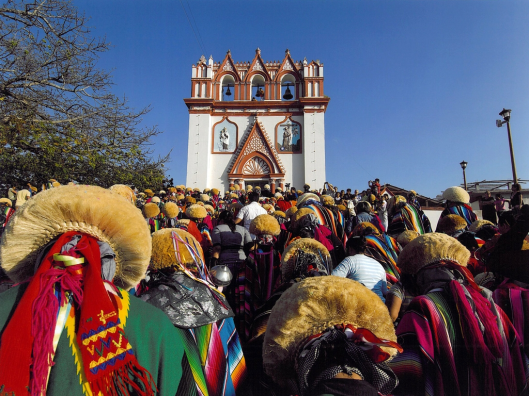
The parade of Parachicos visiting the Iglesia El Calvario, Chiapa de Corzo, Mexico / © 2009 Coordinación Ejecutiva para la conmemoración del Bicentenario de la Independencia Nacional y del Centenario de la Revolución Mexicana del Estado de Chiapas @ UNESCO Archive
Music and Dance: La Danza de los Parachicos
The most essential part of the festival is La Danza de los Parachicos (‘Dance of the Parachicos‘). It has become the highlight of the festival since Nov 2010, when UNESCO declared it as part of the ‘Intangible Cultural Heritage of Humanity’. Referring to both the dance and the dancers, La Danza de los Parachicos is a mixture of pre-Hispanic roots – the music (flute, whistle, drum and rattle) and dance of the local indigenous group, the Chiapanec Maya (los Chiapanecas) – and Spanish colonial tradition. The dance embraces all spheres of local life, promoting mutual respect among communities, groups and individuals. The locals believe that to be a Parachico is not just to wear the costume but you must be born as one [Concepción Nigenda, in Informador]. For this reason, children as young as 6 take part in the festivities, learning the dance through their participation imitating adult dancers [INAH, in Azteca21]. Also, the technique of mask making is passed down from generation to generation, including cutting of the wood, drying, caring and decorating [UNESCO].
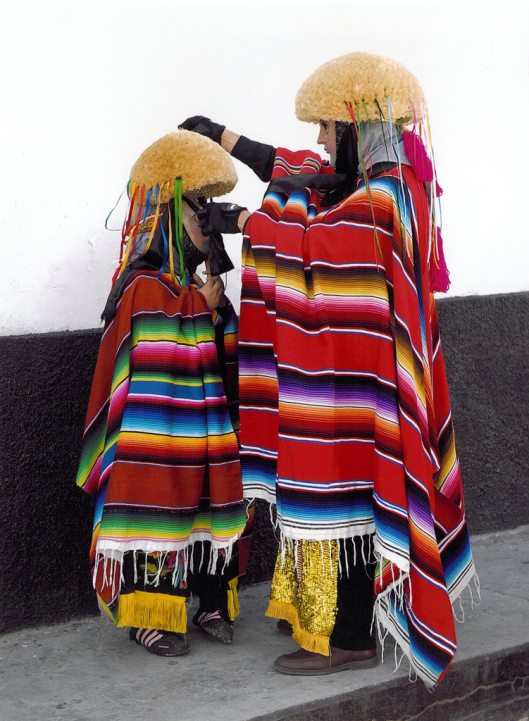
An adult Parachico helping a young Parachico with a montera (‘a round wig made of ixtle’), Chiapa de Corzo, Mexico / © 2009 Coordinación Ejecutiva para la conmemoración del Bicentenario de la Independencia Nacional y del Centenario de la Revolución Mexicana del Estado de Chiapas @ UNESCO Archive
Origins: the Parachicos and the Fiesta Grande
There are several versions of the origin of the Parachicos and the Fiesta Grande. Although the music, dance and masks show the pre-Hispanic roots, the religious syncretism of the Fiesta Grande begins from the 17th century onwards with the arrival of the image of San Sebastian from Spain and the construction of the Iglesia de San Sebastián (C17th, now in ruins) built in Mudéjar style. In other words, the syncretism occurs during the process of acculturation, adapting the indigenous dance with masks, mostly representing animals, in accordance with the Catholic calendar and the legend of Doña Maria de Angulo [Gómez Nigenda, in Aquí Noticias].
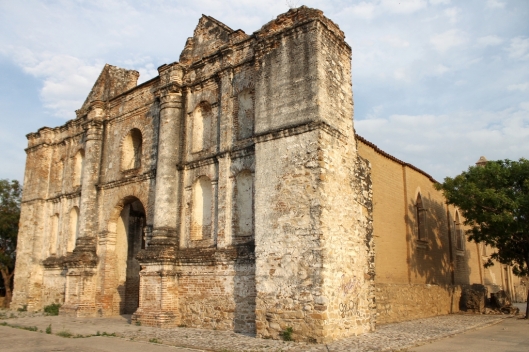
A view from the side of the west front of the Iglesia de San Sebastián, Chiapa de Corzo, Mexico / Kaxita @ Wikipedia
1.Pre-Hispanic Legacy: The Ritual Dance of the Chiapanec Maya
The indigenous tradition has it that the origin of the dance is a pre-Hispanic dance performed by the Chiapanec Maya, accompanied by the musical instruments of flute, whistle, drum and rattle. The church of Santo Domingo de Guzmán keeps an old tree – La Pachota or Kapok (Ceiba pentandra). According to the tradition, the town – Villa Real de Chiapa de los Indos, as it was first known until 1552 – was founded around the tree in 1528 by the Spanish conquistador, Diego de Mazariegos y Porres, who became the first Governor of Chiapas (1528–29). However, the tree is said to represent an important symbol from the Mayan mythology: the World Tree, also known as Yaxche or Arbol de La Vida (‘Tree of Life’). As the tree predates the church, it is suggested that the site was used for ceremonies before the arrival of Christianity [Wikipedia]. It, therefore, seems likely that the Chiapanecas performed a ritual dance around the tree dedicated to two gods – Father Sun and Mother Earth – so that they would get good crops. La Danza de los Parachicos is performed in a circle from right to left with soft, regular steps, following the path of the Sun [Trejo, in Padul Cofrade].
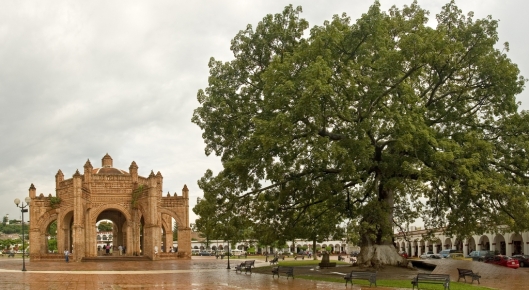
The Fountain, with La Pachota, in front of the church of San Domingo de Guzmán, Chiapa de Corzo, Mexico / © Carolina Garcia Aranda @ Dreamstime (ID 3435210)
2. Spanish Colonial Legacy: The Legend of Doña Maria de Angulo
There are several versions of the story, all of which mainly survive through the oral tradition and are said to derive from the Spanish colonial times.
According to one legend [Castro Aguilar, in NVI Noticias], in mid-18th century Doña Maria de Angulo – a rich and beautiful Spanish Catholic lady from Guatemala – came to Chiapa de la Real Corona (the name for the town between 1552–1881), looking for a cure for her 7-year-old son’s paralytic illness from a local curandero (a ‘traditional native healer’ or ‘shaman’, who is, in the local dialect of Chiapanec Maya, called namandiyuguá). The healer took the child to the healing waters of Cumbujuyú (‘the wild boar’s bath’), and after bathing him for nine days the child was miraculously cured. Shortly after, during the years of 1767–68, the town was hit by a terrible plague of locusts that destroyed the crops of corn, beans, legumes and other pulses. According to the document of 1774 – kept at the Archivio General de Centro America in Guatemala [I.A3.13 expediente2988, file 241] – a devastating epidemic of 1770 that followed the famine of 1769 killed hundreds of people and caused a mass exodus to other places. According to the population census of 1762, the town had 7218 inhabitants, but the number dropped to 1095 by 1778. Learning about these calamities, Doña Maria de Angulo, in gratitude for having healed her child, returned to the town with mules laden with a large supply of money and food (corn, beans, fruits) that her maids distributed from house to house – hence, the origin of Chuntás (from the word chuntá meaning ‘maid’ in the local dialect). In the evenings, her servants danced for the amusement of the children in the memory of Doña Maria’s son – hence, the origin of the Parachicos (from the phrase para el chico meaning ‘for the boy’ or ‘for the child’ in Spanish).
In another version, José Francisco Pascacio [AOC, in Informador], the chronicler of Chiapa de Corzo, explains that Doña Maria de Angulo – an elegant woman of Spanish origin from Central America, who came to Chiapa de Corzo in 1711, looking for a cure for her paralysed child from a healer – had made several promises to Saint Sebastian. The healer told Doña Maria that her son suffered from sadness and that she ought to bathe him in the healing waters of a local lake. While the child was being bathed, the local Chiapanec Maya – disguised as Spaniards with masks – began to dance in order to distract and amuse the boy while chanting Para el chico, para el chico (‘For the boy, for the boy’). It is this entertainment that cured the child. In tribute of this miraculous recovery, Doña Maria offered a party with a Comida Grande (‘Great Meal’) of puerco con arroz (‘pork with rice’) and pepita con tasajo – hence, the origin of the Fiesta Grande.
Whichever version of the story may be a driving force behind the origin of the dance and the Fiesta Grande, it is clear that the philanthropy of Doña Maria de Angulo shaped the local imagination that eventually developed the local tradition passed down from generation to generation within the community. Her generosity towards the poor is honoured with a parade of allegorical floats (cars) (22 Jan).
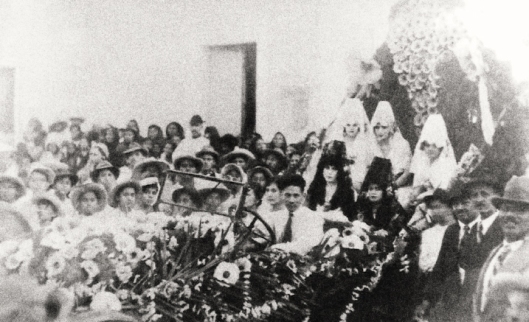
The parade of allegorical cars, 1938 / Courtesy of H. Ayuntamiento de Chiapa de Corzo @ Wikipedia
The Mask of an Identity: Characters and their Costume
Although the Parachicos are the best and most recognised of the dancers, the Chiapenec Maya also, subsequently, developed two other distinct characters – Chuntás (‘maids’) and Abrecampo (‘open the field’) – among many others. The latter marks the route for the parade with allegorical floats (22 Jan), carrying a young lady – secretly chosen every year and representing Doña Maria, who is throwing coins and sweets to people while going through the streets – and is accompanied by the Chuntás, who are, in turn, followed by the Parachicos accompanied by the Patrón [Explore Chiapas].
Although the origin of the use of the masks has not been determined, they have been used for thousands of years and are a reflection of an identity – they are a legend of past, present and future. [Guadalupe Rubisel Gómez Nigenda, in Aquí Noticias]
1. The Patrón: of the Dances and Processions
However, the Patrón (‘patron’, ‘supervisor of the hacienda’) is the maximum authority of the Parachicos, their employer, who deeply knows the tradition and holds the position for life. His authority is stressed by wearing a different mask from the other dancers. His mask represents a mature man – with a severe expression showing him with a full beard, open mouth exposing teeth, wrinkles around forehead, prominent and carefully measured eyebrows, and glass eyes.
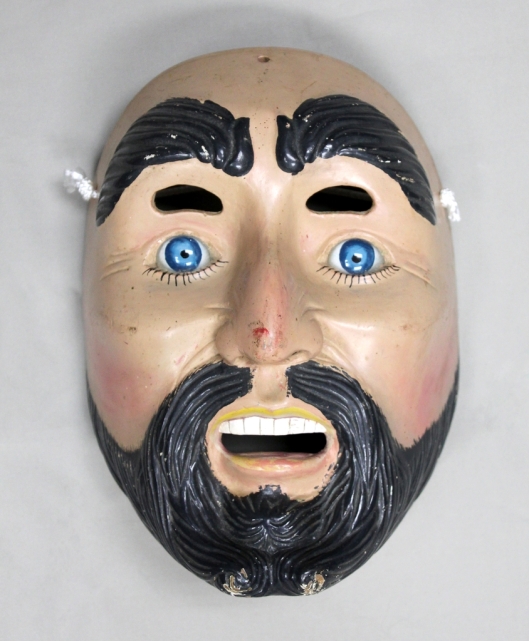
A Patrón mask, William Breitenbach Collection, Newton Gresham Library, Sam Houston State University / © SHSU Digital Collection
He carries a guitar and whip to symbolically punish sin and disobedience, while playing a pito (‘whistle’) accompanied by a drummer.
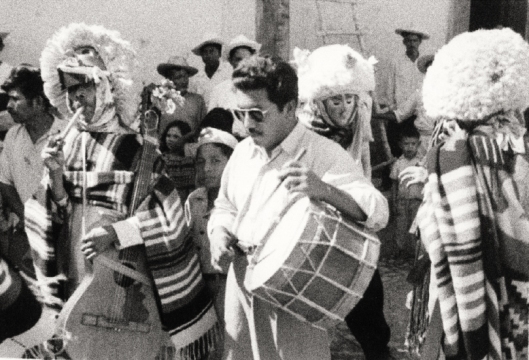
The Patrón of the Parachicos Atilano Nigenda Mendoza, 1948 / Courtesy of H. Ayuntamiento de Chiapa de Corzo @ Wikipedia
In almost three centuries, there have been 20 Patróns. For the last 70 years, the Patrón of the dances and processions has been the Nigenda family, whose house is at 10 Alvaro Obregon Avenue.
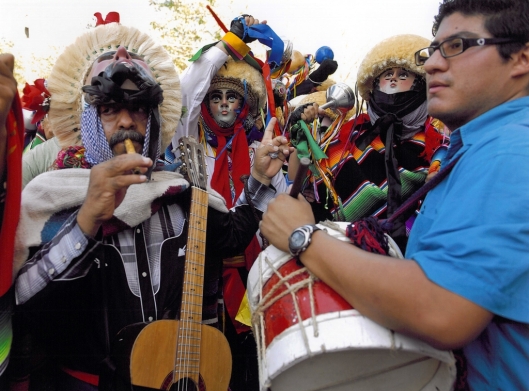
The Patrón Guadalupe Rubisel Gomez Nigenda leading the Parachicos while playing a pito (‘whistle’) and accompanied by the drummer, Chiapa de Corzo, Mexico / © 2009 Coordinación Ejecutiva para la conmemoración del Bicentenario de la Independencia Nacional y del Centenario de la Revolución Mexicana del Estado de Chiapas @ UNESCO Archive
The current Patrón – the third in the family – is Guadalupe Rubisel Gómez Nigenda since 1999 [INAH, in Azteca21], when his uncle, Arsenio Nigenda Tahua (1968–99), ceded his position to him [Cuarto Poder]. His grandfather Atilano Nigenda Mendoza sold his mask in 1948 [see the vintage photo, above], but was donated back to the family’s museum in 2013 [see the mask in El Estado].
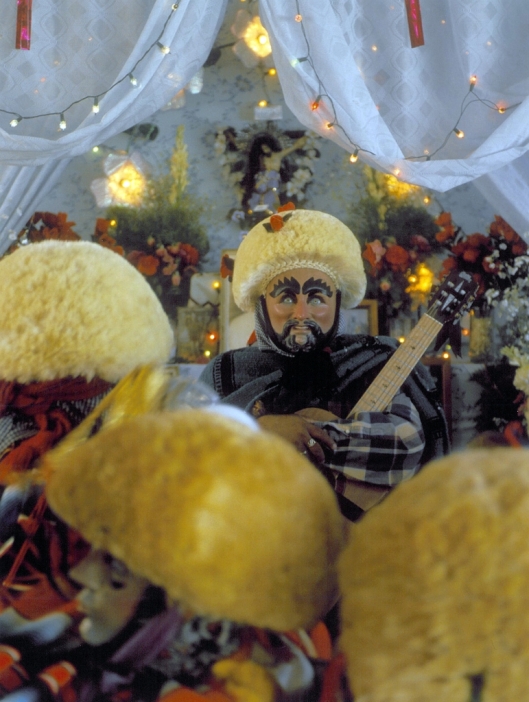
The Patrón Guadalupe Rubisel Gomez Nigenda addressing the Parachicos in a place of worship, Chiapa de Corzo, Mexico / © 2009 Coordinación Ejecutiva para la conmemoración del Bicentenario de la Independencia Nacional y del Centenario de la Revolución Mexicana del Estado de Chiapas @ UNESCO Archive
2. The Abrecampo
The Abrecampo (from ‘abre el campo’ meaning ‘open the field’) is a male character representing the man in charge of the order he had to establish among the people, who gathered around to receive the gifts from Doña Maria de Angulo. He shouted ‘Open the field for Doña Maria de Angulo to go through’. In the dance, the Abrecampo does not wear a mask, while his body is painted black and he carries a broom.

The Abrecampo dancing with a broom and surrounded by young Chuntás distributing sweets, 22 Jan 2011, Chiapa de Corzo, Mexico / © Yadin Xolalpa @ El Universal
3. The Chuntás
The Chuntás (‘maids’) are normally men dressed as women imitating the maids of Doña Maria, who, along with other Spanish servants (Parachicos), went from house to house distributing money and the food. There are two types of their dance: first, as an individual dance, in which they go out to announce the Fiesta Grande and the celebration of the three local saints (8 Jan), while as a group dance, they join the Parachicos in various places of worship during their processions on several occasions throughout the festival, as well as in the parade of allegorical floats (22 Jan).
The Chuntás do not wear masks but have colourful costumes, normally of floral pattern, traditionally done in embroidery. They carry baskets on their heads, decorated with 7 flags and fruits. They give away the fruit to the public, while dancing to the traditional music of tambor (‘drum’) and carrizo (‘reed flute’) and playing maracas (‘rattles’). The act of giving fruits symbolises the fact that their dance reenacts the search for relief from pain and suffering, such as hunger. [Explore Chiapas]
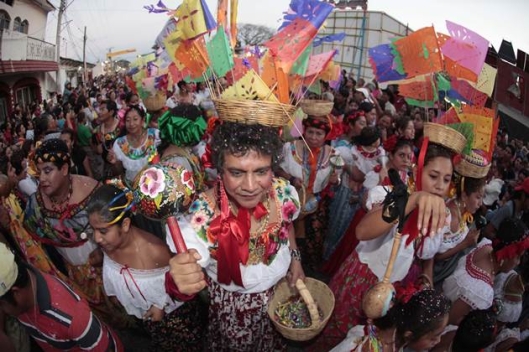
A group of Chuntás in the parade of allegorical floats (cars), 22 Jan 2011, Chiapa de Corzo, Mexico / © Yadin Xolalpa @ El Universal
4. The Parachicos
The Parachicos (‘for the boys’, or nowadays, ‘for the children’) are adults, usually male, who dress to mimic the servants of Doña Maria, who helped to distribute food and money. They perform ritual ceremonies – carrying statues of saints and visiting private homes as well as places of worship – in a procession led by the Patrón, who in turn carries a guitar and whip, while playing a pito (‘whistle’) accompanied by one or two drummers. As they dance to the traditional music of pito y tabor, the Patrón intonates the praises to which the Parachicos respond with cheers.
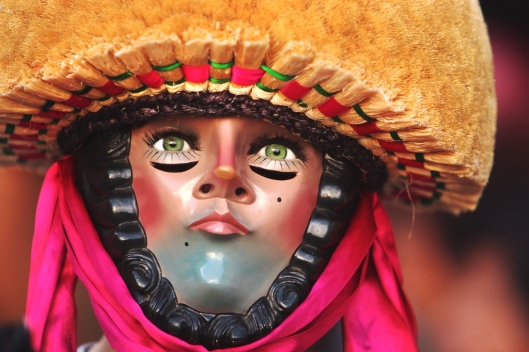
A frontal view of the head of a Parachico, Chiapa de Corzo, Mexico / Amaya Juan @ Flickr
The colourful costume of the Parachicos consists, most importantly, of a carved mask, supposedly, as a shield to hide the wearer’s face, requesting the Sun to protect him from evil and darkness [El Universal], although it is also believed that it is a reflection of the physical characteristics of the Spanish conquistador [Tierra de lo Grande]. Traditionally made out of red cedar, the mask is, in fact, decorated with lacquer to imitate Spanish features – such as light skin, rosy cheeks, facial hair and blue or green glass eyes. The Parachico is depicted with a mutton-chop beard and closed mouth, but over time these masks have also evolved.
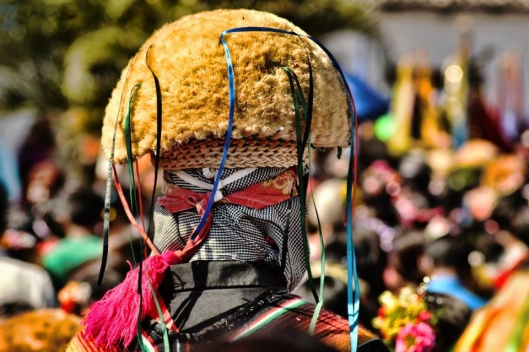
A back view of the head of a Parachico, 15 Jan 2015, Chiapa de Corzo, Mexico / © Moisés Escobar M @ Wikipedia
Furthermore, the Parachicos wear a montera (‘a round wig made of ixtle‘ – i.e. a fibre from agave or yucca plants) supposedly ‘representing the rays of the Sun’ [El Universal] and to mimic blonde hair, with multi-coloured ribbons; a Saltillo style striped serapes; and embroidered shawls, usually over black shirt and trousers. The Parachicos also play tin maracas (‘rattles’) – locally known as chinchin or chinchines – decorated with ribbons attached to the top, and shaken during the dance and chant, apparently ‘to request the divine favour to attract the rain and the fertility’ [El Universal].
Processions: A Ceremonial Ritual of the Parachicos
The Parachicos perform ritual ceremonies for 6 days starting on 15 Jan [see ‘List of Events’ below] in a procession led by the Patrón. They officially start in the morning (10am) and conclude at night (10pm).
Before each parade in the early hours of the morning, several Parachicos – the number of participation throughout the festival has increased by 100 times to around 6000 since 50 years ago [INAH, in Azteca21] – gather at the Patrón‘s house in order to dress their costumes, while a musician is playing the drum very quietly and respectfully. Then, they pray for their health as a group. By 10am, people are already gathered in the streets, and private homes, known as the Priostes houses (‘the houses of the Stewards of the saints’), about 20 or so in total, are ready with food and refreshments. The type of food depends on the day – for instance, the most famous traditional dish of Chiapas, called pepita con tasajo (‘thinly cut beef in sauce of dried pumpkin seeds’), is served to the public for the Comida Grande (‘Great Meal’) (20 Jan).
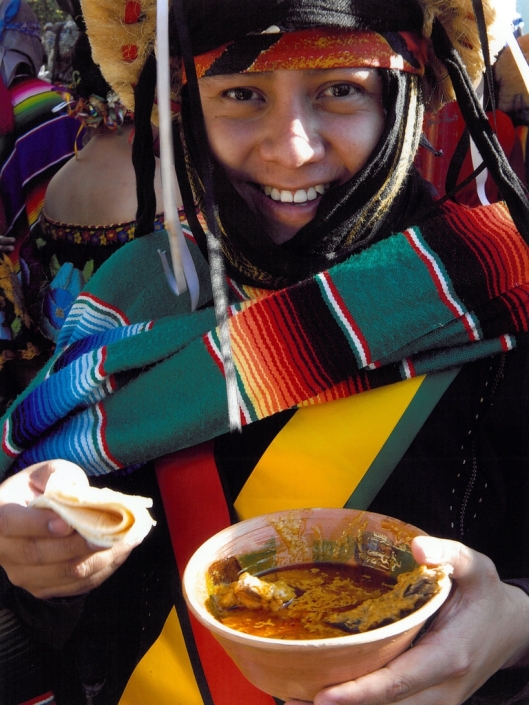
A Parachico eating the traditional dish of Chiapas, called pepita con tasajo, for the Comida Grande, Chiapa de Corzo, Mexico / © 2009 Coordinación Ejecutiva para la conmemoración del Bicentenario de la Independencia Nacional y del Centenario de la Revolución Mexicana del Estado de Chiapas @ UNESCO Archive
The first leaving the Patrón‘s house are the musicians playing reed flutes, whistles and drums. At the signal of tururururutuuu, hundreds of Parachicos start dancing and chanting. Eventually, more Parachicos join in the dance. The last leaving the house is the Patrón accompanied by a Chulita – a young woman without a mask but wearing the traditional costume of Chiapas (a two-part black satin costume, of a long skirt and a shirt, with a pattern of flowers hand-embroidered in vivid silk threads) and representing the women of Chiapas (the Chiapanecas).
During the dance, the Patrón intonates the praises to which the Parachicos respond with cheers, while lifting their feet and moving their bodies. Then follow the flags representing various saints carried by a family member of each Priostes house. At the centre of the Priostes group is the flag of the city’s patron saint and ‘the king’ of the festival, Saint Sebastian.
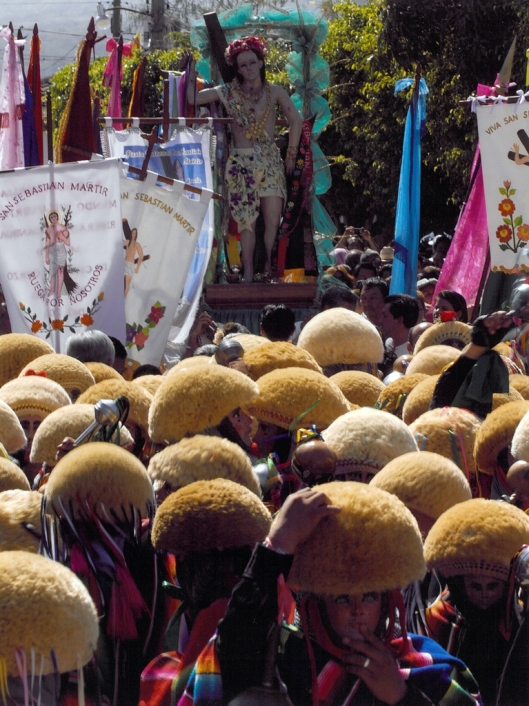
The parade of the Parachicos leading the Priostes group carrying the statue and flag of Saint Sebastian, Chiapa de Corzo, Mexico / © 2009 Coordinación Ejecutiva para la conmemoración del Bicentenario de la Independencia Nacional y del Centenario de la Revolución Mexicana del Estado de Chiapas @ UNESCO Archive
While dancing on the street through various neighbourhoods, the Parachicos visit various Priostes houses and places of worship, which are adorned with enramas (‘interlaced branches of fruits, breads, sweets, as well as flower garlands’).
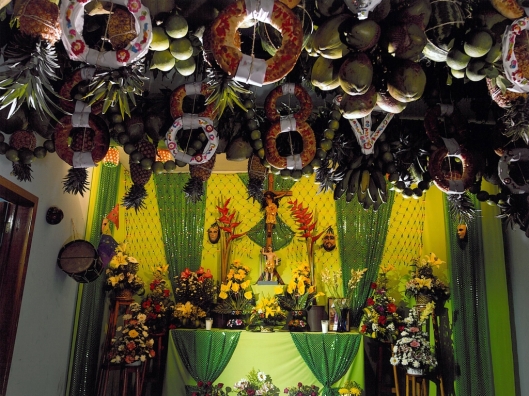
Enramas suspended from the ceiling of a place of worship, Chiapa de Corzo, Mexico / © 2009 Coordinación Ejecutiva para la conmemoración del Bicentenario de la Independencia Nacional y del Centenario de la Revolución Mexicana del Estado de Chiapas @ UNESCO Archive
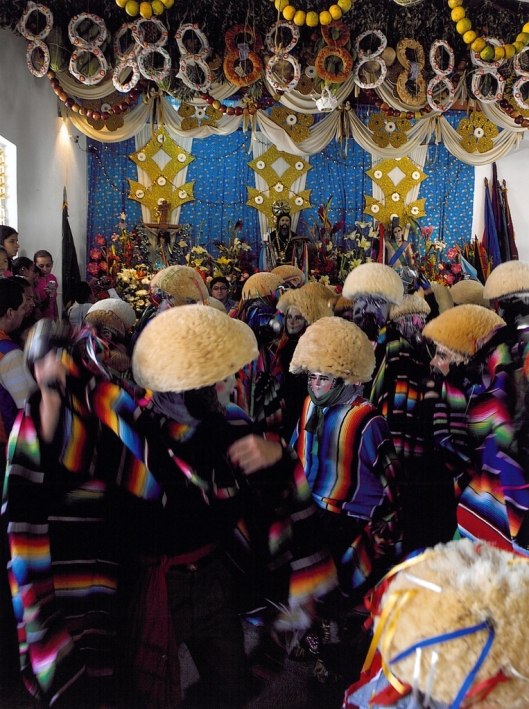
The Parachicos visiting places of worship decorated with enramas, Chiapa de Corzo, Mexico / © 2009 Coordinación Ejecutiva para la conmemoración del Bicentenario de la Independencia Nacional y del Centenario de la Revolución Mexicana del Estado de Chiapas @ UNESCO Archive
In churches, other characters also join the Parachicos: the Abrecampo, the Chuntás and the Chiapanecas [AOC, in Informador].
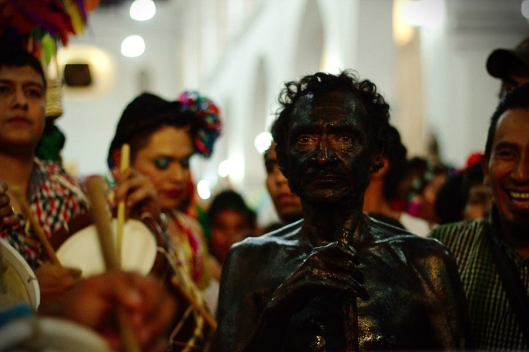
The Abrecampo in a place of worship, Chiapa de Corzo, Mexico / © Ricardo Espinosa @ 500px

A young Chiapaneca wearing the traditional dress of Chiapas, Chiapa de Corzo, Mexico / Tierra de lo Grande
Handcraft: The Making of Masks
Chiapa de Corzo has, therefore, established a reputation as one of the most famous places in Mexico for a high quality artisanship in the craft of mask making [for ‘Mexican Masks’, see Wikipedia]. The masks, mostly carved in red cedar wood, painted and lacquered, have become works of art in their own right, which allow for aesthetic enjoyment – masks with serious, smiling and caricatured faces, with kind and evil appearances [Gómez Nigenda, in Aquí Noticias].
The great workshops of mask makers in the town are, for example, those of Franco Lázaro Gómez, Miguel Vargas Jiménez and Antonio López Hernández. The latter, in particular, is widely recognised for a high quality of mask carving of Parachicos – in 1998 he won the Premio Nacional de Artes y Tradiciones Populares (‘National Prize for Popular Arts and Traditions’).
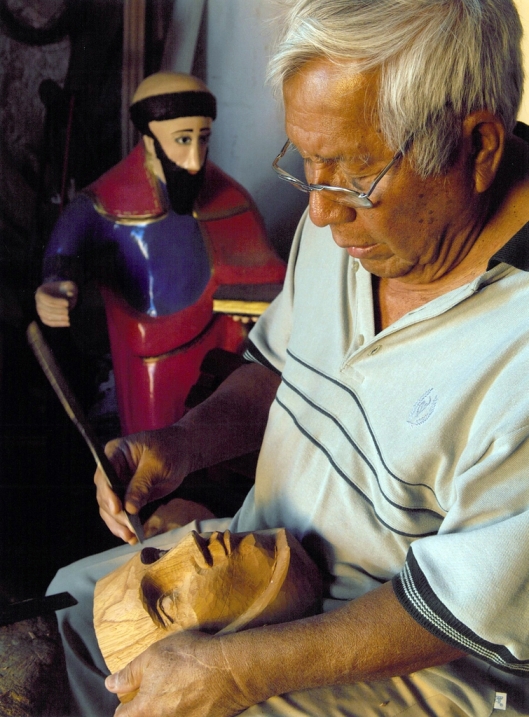
The mask maker Antonio López Hernández at work, Chiapa de Corzo, Mexico / © 2009 Coordinación Ejecutiva para la conmemoración del Bicentenario de la Independencia Nacional y del Centenario de la Revolución Mexicana del Estado de Chiapas @ UNESCO Archive
He makes about 6–8 pieces a year, plus other religious images, based on a technique of carving that he learned in the workshop of his teacher Miguel Vargas Jiménez in the 1950s. He said that the old masks for a Parachico were chubby, had no beard and had a child’s face – but the making of masks, and their final ornamentation, has now evolved due to a mass demand [INAH, in Azteca21]. For instance, a full-bearded Parachico mask was introduced in 1963 – it is ‘similar to that of the Patrón mask as it has a closed mouth and wrinkles but similar to the traditional Parachico mask when comparing the nose and mouth’ as it can be seen in the two images below from the William Breitenbach Collection [Williamson, Sam Houston State University].
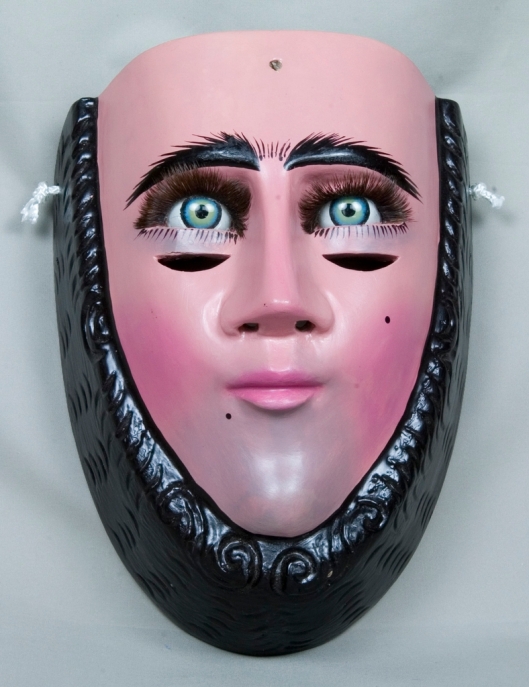
A Parachico mask, William Breitenbach Collection, Newton Gresham Library, Sam Houston State University / © SHSU Digital Collection
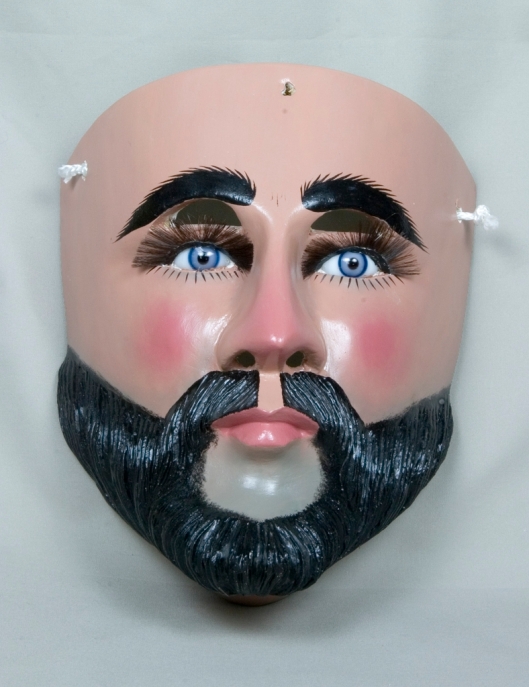
A bearded Parachico mask, William Breitenbach Collection, Newton Gresham Library, Sam Houston State University / © SHSU Digital Collection
List of Events of the Fiesta Grande
Although the Fiesta Grande is celebrated every day (Link 2017 programme), the most representative days are as follows (in red).
- 8 Jan – Announcement of the Fiesta Grande and of the celebration of the three local saints is made by the first dance of the Chuntás led by the Abrecampo.
- 14 Jan – Announcement of the Feast of Saint Anthony the Abbot.
- 15 Jan – Feast of Our Lord of Esquipulas is celebrated at the church of Iglesia del Señor de los Milagros (10am). The first parade of the Danza de los Parachicos.
- 16 Jan – Announcement of the Feast of Saint Sebastian the Martyr by by the second dance of the Chuntás led by the Abrecampo.
- 17 Jan – Feast of Saint Anthony the Abbot. The second parade of the Danza de los Parachicos.
- 18 Jan – The third parade as the Parachicos visit the graves of their deceased Patrónes.
- 19 Jan – Announcement of the Party in the Park.
- 20 Jan – Feast of Saint Sebastian the Martyr. The fourth parade of the Danza de los Parachicos. Activities start early in the Santuario de San Sebastián Mártir. The most famous traditional dish of Chiapas, called pepita con tasajo (‘thinly cut beef in sauce of dried pumpkin seeds’), is served to the public for the Comida Grande.
- 21 Jan – Representation of the Naval Combat recalling the battles of the conquest of 1524 and 1528 between the Spaniards and the Chiapanec Maya on the Rio Grijalva (‘Grijalva River’), and of the subsequent uprising of 1532 and 1534 – takes place in the form of a spectacle of fireworks. According to the writings of Bernal Díaz de Castillo, who accompanied Hernán Cortés‘s expedition during the conquest of New Spain, the Chiapanec Maya were ‘the best warriors I have seen in all of New Spain’. They were the last indigenous group of Mexico to have been conquered by the Spaniards – led under the campaign of the conquistador Diego de Mazariegos y Porres – in 1528, who, with their continuous resistance that led to their near extinction, became finally absorbed into the Spanish Crown on 28 Aug 1552. The tradition of fireworks began in 1599, when Pedro de Barrientos, a vicar of the 16th-century church, Santo Domingo de Guzmán, encouraged the development of fireworks making. He invented the idea of a naval battle.
- 22 Jan – The fourth parade with allegorical floats (cars) representing the entourage of Doña Maria de Angulo, the benefactor of the city in colonial times, dressed as a beautiful lady giving sweets and coins to the public. The figure of the Doña is represented by the secret election of a young lady from the community. The parade is headed by Abrecampo, Chuntás and Parachicos, who are dancing to the sound of the flute and drum. Also, a day of confetti and mariachis.
- 23 Jan – The last and six parade of the Danza de los Parachicos. The festival is concluded when the change of the Priostes (‘Stewards of the Saints’) takes place and the Parachicos attend a thanksgiving mass in the church of Santo Domingo de Guzmán (5pm). The images of the saints are given to new Priostes families, who will look after the images for a year. After the mass, the Parachicos accompany the Patrón to his home for the last dance in order to give a farewell to this year’s party and wait for the next year [Explore Chiapas]. During these last hours, the drums and flutes play a melancholy tune as the fireworks end and the streets become quiet.
Bibliography
- AOC. 2010. “La Fiesta Grande de Chiapa de Corzo.” Informador. 29 Nov 2010. Article [Accessed 6 Jan 2017].
- Aquí Noticias Editorial. 2014. “La máscara reflejo de identidad, leyenda, pasado, presente y futura: Rubisel Gómez Nigenda.” Aquí Noticias. 27 Oct 2014. Article [Accessed 6 Jan 2017].
- Castro Aguilar, José Luis. 2014. “Todo es grande.” NVI Noticias. 20 Jan 2014. Article [Accessed 6 Jan 2017].
- El Universal Editorial. 2014. “¡Allí vienen los parachicos!” El Universal. 12 Jan 2014. Article [Accessed 6 Jan 2017].
- Expore Chiapas Editorial. 2011. “La Fiesta Grande: Heroica Cuidad Chiapa de Corzo.” Explore Chiapas. 1 Oct 2011. Article [Accessed 23 Jun 2018].
- Hursh Graber, Karen. 2003. “The cuisine of Chiapas: Dining in Mexico’s last frontier.” Mexconnect. 1 Jan 2003. Article [Accessed 6 Jan 2017].
- INAH. 2011. “Tradición de Los parachicos de Chiapa de Corzo, vive tiempos de auge y desafío.”Azteca 21. 21 Jan 2011. Article [Accessed 6 Jan 2017].
- López Ruiz, Sergio Alejandro. 2013. “Los Chuntás y el Abrecampo.” Todos Chiapas. 8 Jan 2013. Article [Accessed 6 Jan 2017].
- López Ruiz, Sergio Alejandro. 2013. “Pepita con Tasajo.” Todos Chiapas. 21 Jan 2013. Article [Accessed 6 Jan 2017].
- Mark, Joshua J. 2012. “The Mayan Pantheon: The Many Gods of the Maya.” Ancient History. 7 July 2012. Article [Accessed 6 Jan 2017].
- Mendoza, Darwin. 1999. “Último día de los parachicos.” Cuarto Poder. 23 Jan 1999. Article [Accessed 6 Jan 2017].
- Official website of the festival. “Fiesta Grande: La Fiesta de Enero.” Tierra de lo Grande. Article [Accessed 6 Jan 2017].
- Press Agency. 2016. “Parachicos, alma de las tradiciones chiapanecas.” El Estado. 16 Jan 2016. Article [Accessed 6 Jan 2017].
- Thomas, Scott. “The Black Christ of Esquipulas: A Brief Look into El Cristo Negro.” Article [Accessed 23 Jun 2018].
- Trejo, Ángel. 2003. “Así se celebra la festividad de San Sebastián en: Chiapa De Corzo (México).” Padul Cofrade. Article [Accessed 6 Jan 2017].
- UNESCO. 2010. “Parachicos in the traditional Januar feast of Chiapa de Corzo.” UNESCO: Intangible Cultural Heritage. 16 Nov 2010. Article [Accessed 6 Jan 2017].
- Williamson, James. 2013. “Danza de los Parachicos from William Breitenbach Collection of Mexican Masks.” Out of the Box: Treasures of Newton Gresham Library. Huntsville: Sam Houston State University. 5 March 2013. Article. More on the Breitbenbach Mexican Mask Collection, see here [Accessed 6 Jan 2017].
